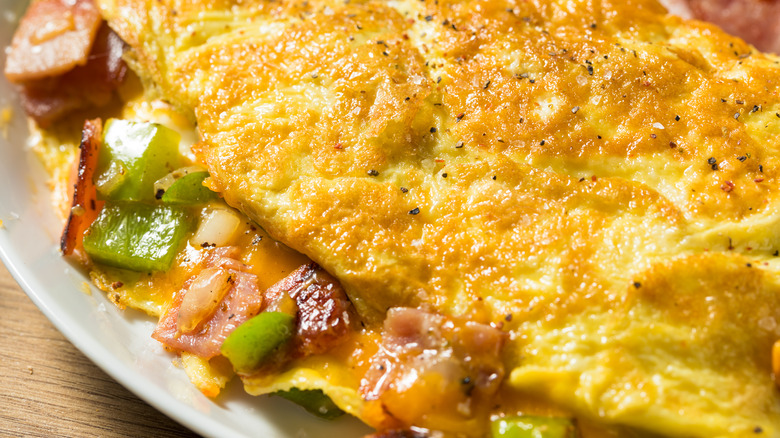The Secret To The Absolute Best Omelet Is Cooking The Fillings First
Unlike French omelets, which are a creamy mixture of butter and eggs rolled into a soft cylinder with few or no other ingredients, the American omelet is commonly stuffed with any number of options. From cheese to herbs, meats, and vegetables, omelets take many forms, all of which begin and end with a casing of eggs. Although a seemingly basic dish, there are many layers to producing the perfect omelet, starting with properly preparing the chosen fillings.
For fresh ingredients, such as chopped tomatoes, sliced avocados, or mixed greens, simply wash, cut to size, and set aside. Herbs such as thyme, rosemary, sage, mint, basil, and oregano kick up the flavor profile of any omelet, and you can add them at just about any stage of the omelet-cooking process. Combine minced herbs with the whisked eggs before cooking, toss a few leaves into the center of the omelet, or use fresh herbs to garnish your finished dish. To create the best balance of flavor and texture for your omelet, pre-cook other add-ins, such as vegetables and meat.
Why omelet fillings need to be pre-cooked
When whisked eggs are spread into a thin layer in a pan, they only take a few minutes to cook. Uncooked meats like bacon or sausage take longer to prepare, and it's important to ensure they cook to a safe temperature. Beyond food safety, each ingredient should be at optimal tenderness before getting tucked into the omelet envelope. Pre-cooking crunchy vegetables such as sweet peppers, asparagus, and potatoes will provide a softer texture to pair with your eggs.
Some vegetables are just as good raw as they are cooked, so whether you'd like to cook them first or simply layer them in becomes a matter of preference. For example, you can use spinach as a green topping or slightly sauté it before addition. The same goes for onions, shallots, leeks, garlic, and similarly strong flavors. Pre-cooking and even caramelizing these foods offer a sweeter flavor profile and gentler consistency to your finished omelet.
How to pre-cook your omelet ingredients
As a rule of thumb, cook your omelet ingredients to the desired doneness before adding them to your dish. All meats should be cooked thoroughly. It doesn't matter whether you prefer ham, linguica, bacon, or reindeer meat — cook it first. Omelets are a great way to use leftovers, so expedite the process by checking the fridge for cooked or cured meats such as roast beef, pork tenderloin, crab, prosciutto, pancetta, or smoked salmon.
Cook your vegetables to the desired consistency. For mushrooms, a few minutes in a sauté pan with butter will brown them and release moisture. In contrast, cubed potatoes take 15-20 minutes to cook. Common vegetable additions like peppers, asparagus, and zucchini require 5-10 minutes of cooking.
Cheese is another favorite omelet ingredient, and there are countless options. To enhance your omelet, use a microplane to finely shred hard cheeses like parmigiano or pecorino and add them directly to the whisked eggs prior to cooking. For cheeses that melt fairly easily, such as cheddar, feta, goat cheese, or gruyere, mix them in with meats or veggies while they are still hot. This will allow them to warm and soften so they melt more completely inside the omelet.


